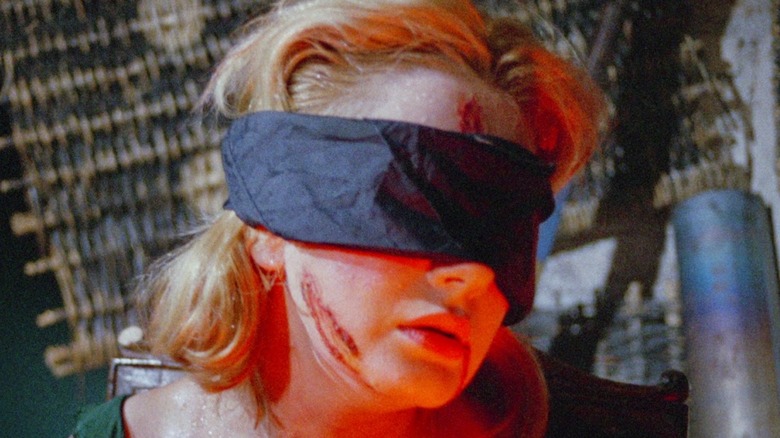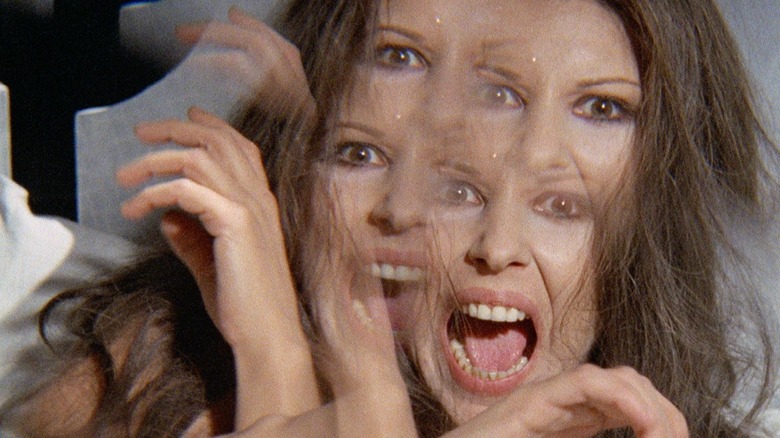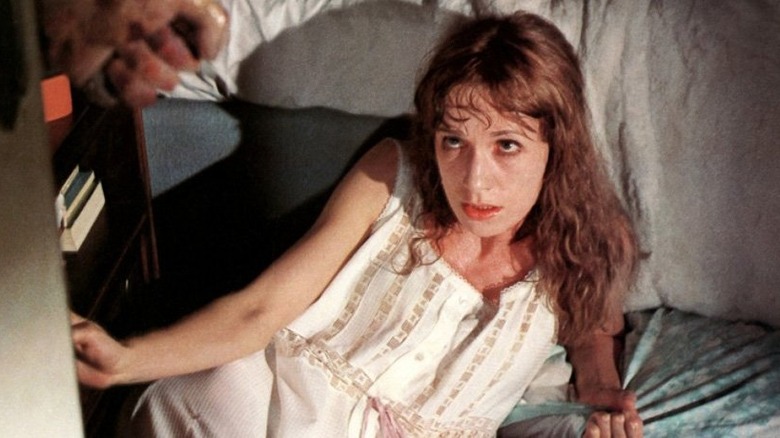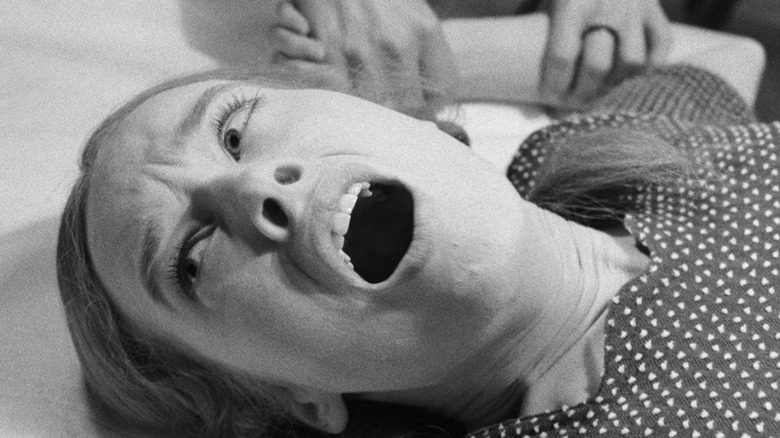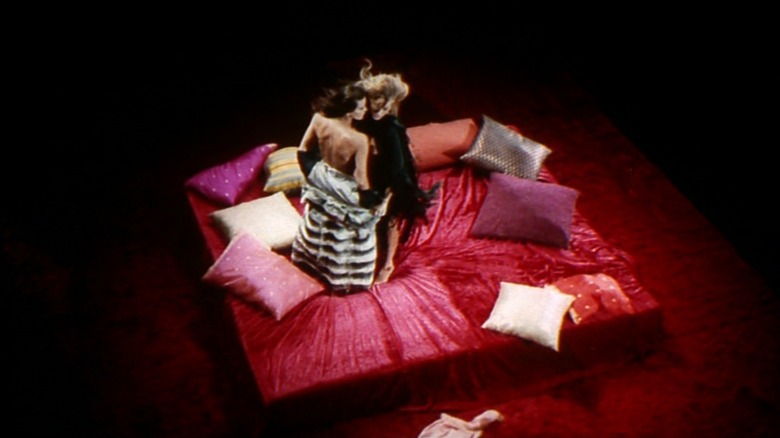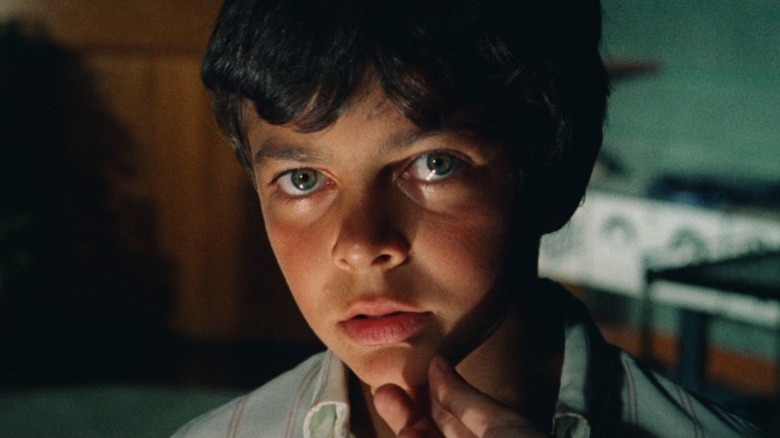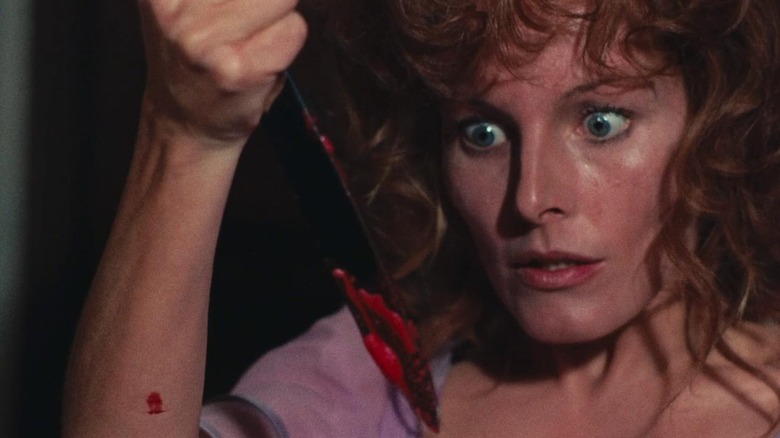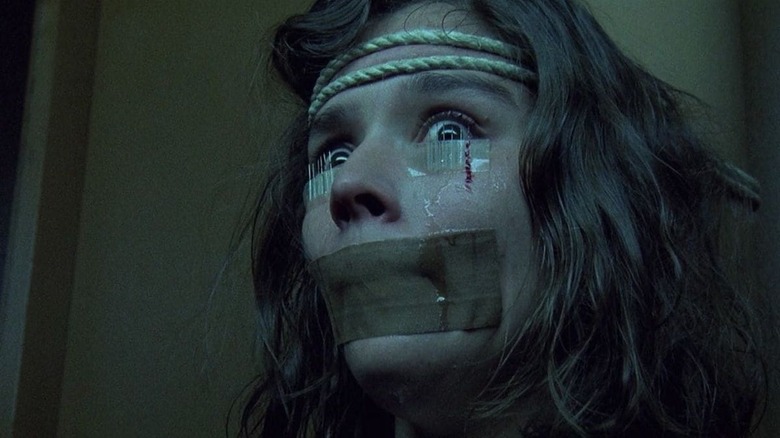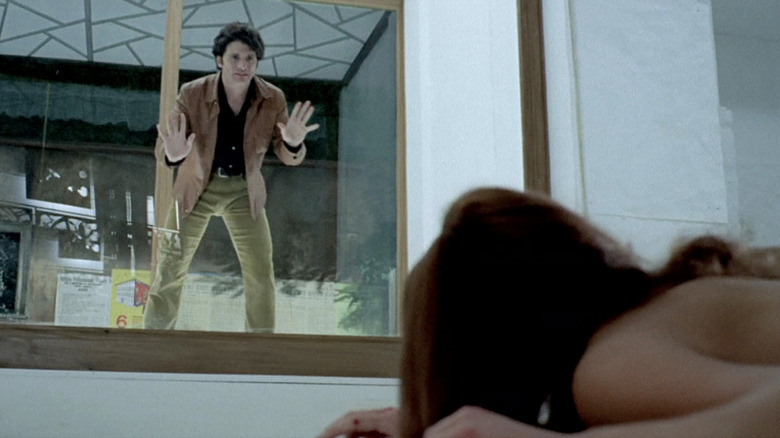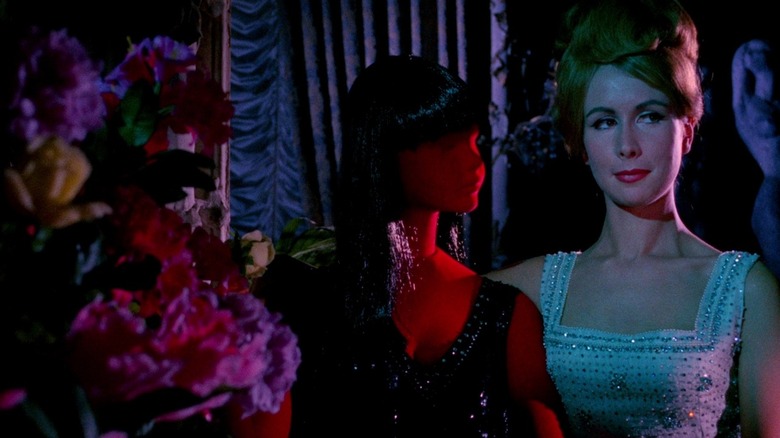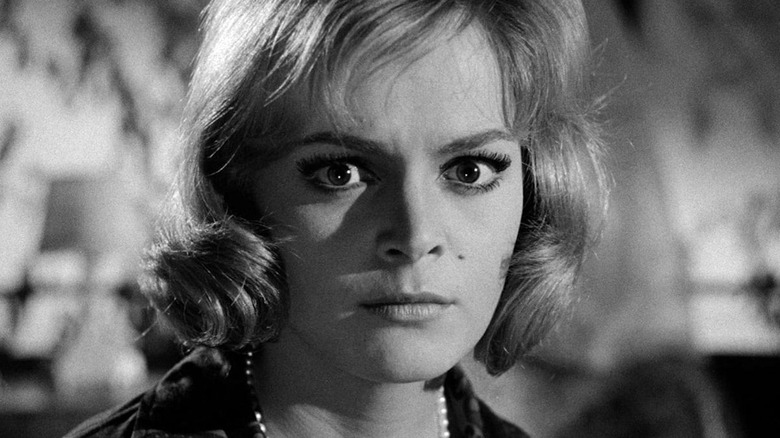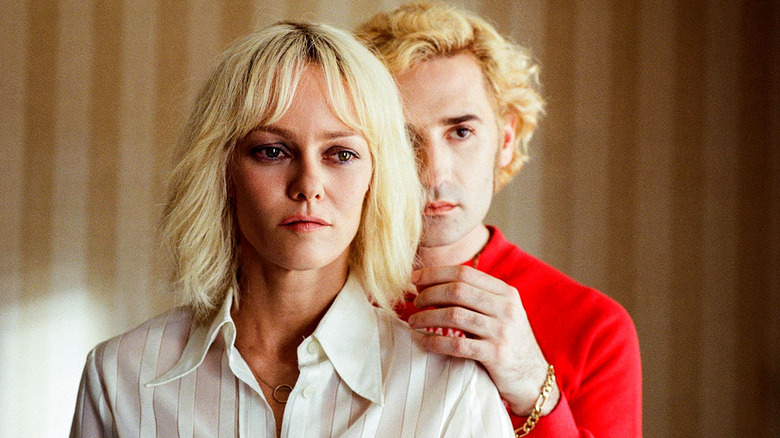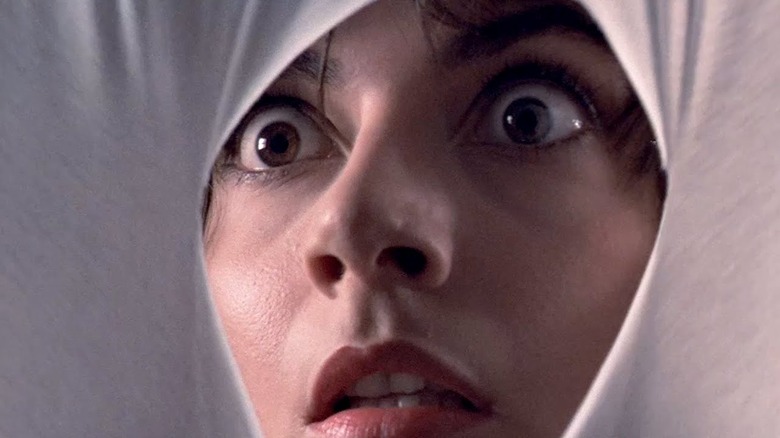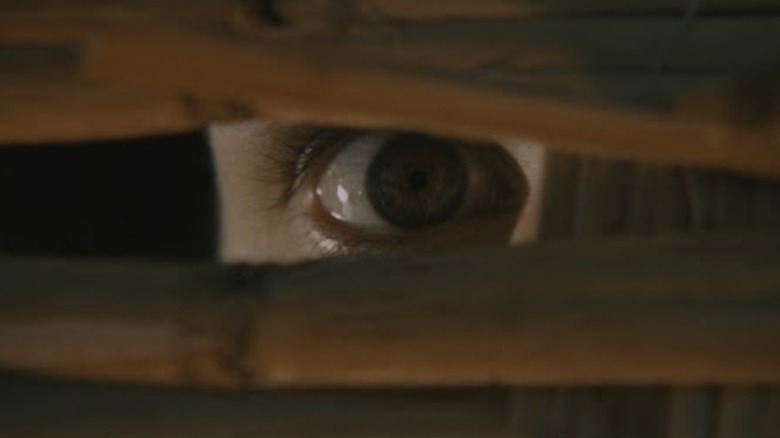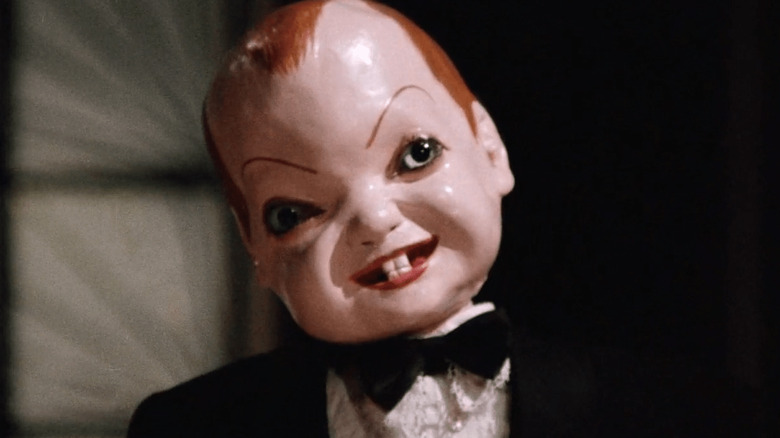The 14 Best Giallo Films Ranked
Black leather gloves. Bold colors. Incredible architecture. Gory kills. If you found yourself nodding along with each phrase, then you may just love giallo. Giallo, which literally means "yellow" in Italian, is a subgenre of Italian horror-thrillers that are believed to have emerged 1963 with the release of Mario Bava's "The Girl Who Knew Too Much" (more on that later in the rankings). While giallo was predominantly created in the 1960s and 1970s in Italy, the subgenre is alive and well today and has spread across the globe.
But what does yellow have to do with giallo? Yellow was the primary color used on the covers of the crime thrillers of the 1950s and 1960s. So, giallo became synonymous with thrillers rather than just the color. Directors such as Bava and Dario Argento are staples of the genre, shaping the bold aesthetics that gialli (the plural of giallo) are known for. Each frame of a giallo looks like something out of a high fashion magazine, perfectly lit and posed to create a work of art. The films are also defined by creative and strange kills and a complicated web of sexual relationships that always factor in the string of mysterious murders. Giallo is over-the-top, gruesome, and glamorous.
We're going to rank the best 14 giallo films out there, the ones that you need to watch if you're starting to explore the subgenre. So, pull on those leather gloves. It's time to get bloody.
14. All the Colors of the Dark
Director Sergio Martino is a giallo staple, and this isn't the last time his name is going to pop up on this list. We're kicking off this ranking with his 1972 giallo "All the Colors of the Dark," starring Italian starlet Edwige Fenech. She plays Jane, who has just suffered a miscarriage and has been coping with the trauma of watching her mother's murder when she was a child. So, as an alternative to therapy, Jane decides to attend a Black Mass and looks to Satan for a way to heal. But this sect of cultists doesn't have the purest intentions for Jane, and her sanity begins to crumble as more murders begin to happen around her.
Martino mixes giallo sensibilities with Gothic horror, creating intricate set pieces bathed in candlelight and madness. "All the Colors of the Dark" exists right on the border of giallo and supernatural horror, and Martino beautifully navigates that divide. Is this hell all in Jane's head? Or is she actually descending into the fiery pits of the underworld?
13. Shock
"Shock" is another giallo that teeters on the precipice of the supernatural and just barely keeps itself from tipping into your typical ghost story. It's also the source of the incredible scene in which a young boy running towards his mother transforms into a grown man. Mario Bava's 1977 film stars Daria Nicolodi as Dora, who was recently released from a mental institution following the mysterious death of her abusive first husband. She moves back into her home with her ex, along with her son Marco and new husband Bruno. But something is different; Dora feels as if the house is haunted and her son is possessed by the spirit of her dead husband.
This isn't just a film about ghosts, though. "Shock" deals with trauma and the tumultuous experience of trying to heal from those mental wounds. Dora has suffered years of abuse at the hands of her ex, and is still trying to process the violence and how it has affected both herself and her son. Bava uses the meticulously designed space of Dora's home to create a cerebral slow burn that places the viewer at the center of the madness.
12. What Have You Done to Solange?
Right off the bat, I should let you know that the titular Solange is not brought into the plot of the film until about 45 minutes in. For the giallo lovers, that fact isn't surprising, as the genre is known for its strange pacing and twisted narrative paths that don't always quite make sense. And yet, that's why we love these films. It's all about the bizarre journey rather than the destination.
Massimo Dallamano's 1972 film "What Have You Done to Solange?" is a tragic tale about sex, friendships, and, ultimately, abortion. The victims of this film are young female students, some of whom have had a secret affair with their male professor. He is, unsurprisingly, both an absolute jerk and also the prime suspect. But that's too obvious of a choice for the killer, and he instead begins to investigate the truth behind the crimes.
These women are killed by objects forcibly shoved inside of their vaginas, creating rather graphic and perverse crime scenes. "What Have You Done to Solange?" earns its place on this list due to its rather progressive subject matter and sexually graphic murders, as well as its harrowing conclusion.
11. A Lizard in a Woman's Skin
Gore master Lucio Fulci makes his first appearance on this list with his 1971 giallo "A Lizard in a Woman's Skin." Known for films such as "Zombi 2" and "The Beyond," Fulci dipped his toes into giallo with a hallucinogenic nightmare about repressed sexuality and respectability politics.
Carol Hammond (Florinda Bolkan) lives in a large apartment with her husband, wealthy father, and young stepdaughter. Their apartment shares a wall with neighbor Julia (Anita Strindberg), who loves to throw wild parties that rage late into the night. Carol is infuriated by these parties, but is also a little excited by them. They go against her rigid upbringing, causing her to have vivid sexual fantasies about joining these parties and presumed orgies. But these desires are also manifesting as violent dreams, which start to leak into reality. They become murderous hallucinations as Julia is found dead. So, is Carol the killer? You'll have to watch to find out. This is Fulci's response to the emerging counterculture of the time, so of course there are a few freaky hippies to really make his point clear.
10. Don't Torture a Duckling
Like Mario Bava, Lucio Fulci wasted no time between giallo films, releasing "Don't Torture a Duckling" in 1972, just one year after "Lizard in a Woman's Skin." However, with this film, Fulci utilized a much bleaker and more monochromatic color palette to tell a devastating tale about a murderer who targets not only adults, but young children, too. Child death is taboo, even in the horror genre, so these deaths in "Don't Torture a Duckling" feel especially horrific.
But, somehow, even more terrifying is the death of the town witch, La Magiara (Florinda Bolkan, star of "Lizard in a Woman's Skin"). She's suspected to be the child killer, and is targeted by townspeople in the local graveyard. There, they beat her to the brink of death with heavy chains. It's an agonizing scene, with Fulci never cutting away from her shattered body and the sounds of the chains landing on her flesh. Giallo is often stylish with its kills, but here Fulci makes death just plain gruesome.
9. Your Vice Is a Locked Room and Only I Have the Key
Sergio Martino's 1972 film has the quintessential giallo title: so long that it's essentially a complete sentence. "Your Vice Is a Locked Room and Only I Have the Key" swirls around a husband, wife, and his niece, all trapped in a decaying house with nothing but anger and resentment bubbling around them. This isn't the typical urban giallo, but something more gothic, not unlike "Shock."
Husband Oliviero (George Hilton) and wife Irina (Anita Strindberg), to put it bluntly, hate each other. They antagonize each other, with Oliviero abusing, raping, and demeaning his wife. Then, his niece Floriana (Edwige Fenech) comes to visit from France, only further stirring the nasty pot of hate brewing in this decrepit domicile. Plus, there's a large black cat named Satan that stalks the halls and attacks seemingly innocent people. Remember, folks, always trust the cat.
Martino based the film's script on Edgar Allen Poe's infamous short story "The Black Cat," which gives you an idea of the tragic twists of the film. While a lot of gialli are incredibly bleak, this one is particularly dark, with misery seeping out of every shadow.
8. Opera
Music meets murder in Dario Argento's 1987 film "Opera," known primarily for the use of needles under victims' eyes to keep them from closing. Cristina Marsillach plays Betty, the understudy in a production of "Macbeth" who gets the opportunity to play Lady Macbeth after the opera's star is injured. But, once she takes the role, a killer captures her and deploys those needles so that she is forced to watch the murder of her boyfriend.
This cycle repeats throughout the film, and reminds Betty of how her mother was killed when Betty was a child. These aspects of Betty's memories, paired with the beauty and intricacy of the opera house and a score that utilizes the shrill caws of the ravens that call the performance space home, make "Opera" surreal and bizarre. It's another bleak commentary on the nature of trauma and deep psychological scars that never fully heal, no matter how many years pass.
7. The Bird with the Crystal Plumage
Dario Argento is a horror legend, and has been since the release of his first film in 1970, "The Bird with the Crystal Plumage." Here, American writer Sam Dalmas (Tony Musante) is vacationing in Rome with his girlfriend Julia (Suzy Kendall), trying to get past his writer's block. Luckily— or perhaps not so luckily — right before he's set to return home, Sam witnesses a murder in an art gallery. As is giallo tradition, Sam decides to play cop and help identify the killer. But that puts him, and Julia, in danger, as the killer doesn't want anyone interfering with their murderous intentions.
The story, while still full of typical giallo twists and turns, is Argento's most straight-forward and narratively cohesive. "The Bird with the Crystal Plumage" allows Argento to stretch his wings (pun intended) and get situated in the world and aesthetics of giallo. It may not be as visually rich as his later films, but it's still just as shocking and enthralling as any other giallo by Argento or other Italian filmmakers.
6. Blood and Black Lace
Just one year after the release of "The Girl Who Knew Too Much" in 1963, Mario Bava brought his next giallo masterpiece to the world. Like his previous film, "Blood and Black Lace" shaped the idea of what giallo was and continues to be. Instead of following convention, it created it. What it lacks in narrative cohesion, it makes up for with stunning visuals that prove the beauty of the giallo subgenre. Story doesn't matter when there are striking images and dead bodies to look at, after all.
The film follows a fashion house whose workers are picked off one by one by a masked killer wearing a long trench coat and a black fedora. The killer is trying to hide the contents of a victim's diary, which is full of secrets about each and every employee of the small business. The movie's connection to the fashion world lends itself to a stylish film that reflects the glamor of the industry, but not without a few splatters of blood for color.
5. The Girl Who Knew Too Much
As mentioned in this list's introduction, Mario Bava's 1963 film "The Girl Who Knew Too Much" is often cited as the first giallo film. It follows Nora (Leticia Roman), an American obsessed with giallo novels who travels to Italy to visit her dying aunt. While she's there, she becomes entangled in a murder investigation and believes that, since she's read so many giallo, she can solve the case. But, of course, her own life is in danger as she wanders into abandoned buildings, and must hide in her own massive living space from her killer.
Bava's use of wide spaces played a pivotal role in establishing the giallo trope of large sets that dwarf the film's characters, making them seem insignificant in the face of the grand architecture. Shot in black and white, "The Girl Who Knew Too Much" doesn't rely on bold colors, but rather the stark contrast between light and dark. This film is the perfect pairing with almost any giallo, allowing you to see just how much the subgenre evolved and took shape over a mere decade.
4. Knife+Heart
Yann Gonzalez's 2018 film, "Knife+Heart" is the only contemporary choice on this list. It deserves a place among the biggest giallo hits of the 1960s and 1970s not only for its colorful aesthetic choices, but also for focusing its narrative on queer communities and sex workers.
Anna (Vanessa Paradis) is a gay porn producer with a broken heart. Her editor and partner, Lois, has recently left her, and Anna wants her back. But when trying to create the porno to win Lois's heart, Anna's actors are murdered one by one by a killer in a leather mask with a dildo turned into a knife. Anna is then placed at the center of this bloody plot, trying to unravel the truth while also trying to keep her career afloat.
Gonzalez takes the giallo tropes of bold colors, intricate plots, and masked killers and brings them into the modern era. While the film takes place in 1979 and has that retro vibe, Gonzalez still brings the genre into contemporary conversation by creating a new, queer vision on what the giallo can be.
3. Tenebrae
We already know that Dario Argento doesn't miss, at least with his giallo films, and his 1982 effort "Tenebrae" is no exception. In fact, it's one of his best. The film follows familiar giallo beats, with an American writer becoming embroiled in a murder case while visiting Italy. Here, writer Peter Neal is in Italy on a book tour for his latest novel, "Tenebrae." He receives a note from a killer, which says that Neal's latest novel inspired him to kill, which I can only imagine is any creator's worst nightmare. He works with the police and his assistant (Daria Nicolodi) to crack the case.
The most breathtaking moment in the film involves a long take through the apartment of a lesbian couple who are eventually murdered by the killer. This shot, according to Argento, was incredibly complex and took three days to shoot. That effort paid off, though, and it is truly an unforgettable moment in horror and cinema history. The incredibly shocking ending of "Tenebrae" is one the most cohesive in giallo, which isn't always known for its straightforward or comprehensible conclusions.
2. A Bay of Blood
Also known as "Twitch of the Death Nerve" (an absolutely incredible title), Mario Bava's 1971 film "A Bay of Blood" is not only a giallo, but feels like a direct precursor to the then-upcoming slasher genre in the United States and Canada. In all fairness, giallo in general is the godfather of the subgenre, but the opening sequence and slaughter of young adults while in the throes of passion in particular screams proto-slasher. The cold open involves an old woman in a wheelchair meeting her untimely demise at the hands of her husband, who is in turn stabbed by an unknown killer.
That's just the beginning. What follows is an incredibly bloody film in which it seems that citizens of a small town on the bay are murdered indiscriminately and without mercy. One particular murder involves a spear being driven through a couple mid-coitus, piercing not only their flesh but the mattress and the floor beneath. This death is copied almost shot-for-shot a decade later in "Friday the 13th Part 2." There's no denying the prevailing influence of "A Bay of Blood" on the genre, and the blueprint it provided to the filmmakers who went on to create some of the meanest villains in horror history.
1. Deep Red
The best giallo on this list is also a Christmas horror movie. Yes, you read that correctly. "Deep Red" begins with a murder sequence in front of a Christmas tree, while the credit sequence unfolds around children's toys. After the bloody opening, Dario Argento's film follows an American jazz pianist Marcus Daly (David Hemmings) who discovers his neighbor's mutilated body. As always seems to happen in giallo, he becomes intimately involved with the case, seeking out the killer himself. Along the way, he works with reporter Gianne Brezzi (Daria Nicoldi) to solve the murder.
This is narratively and aesthetically the quintessential giallo film. The game of cat-and-mouse between Daly and the killer is complex and takes some incredible twists and turns. On top of that, the sense of architectural scale and bold colors makes this film feel like a work of art. This is also one of the few giallo films that includes gay and trans characters, though their representation isn't the most progressive. Still, "Deep Red" contains some of giallo's most brutal depths, including a scalding scene that later influenced director Rick Rosenthal when he made "Halloween II." If there's one giallo film you watch, make it this one.
